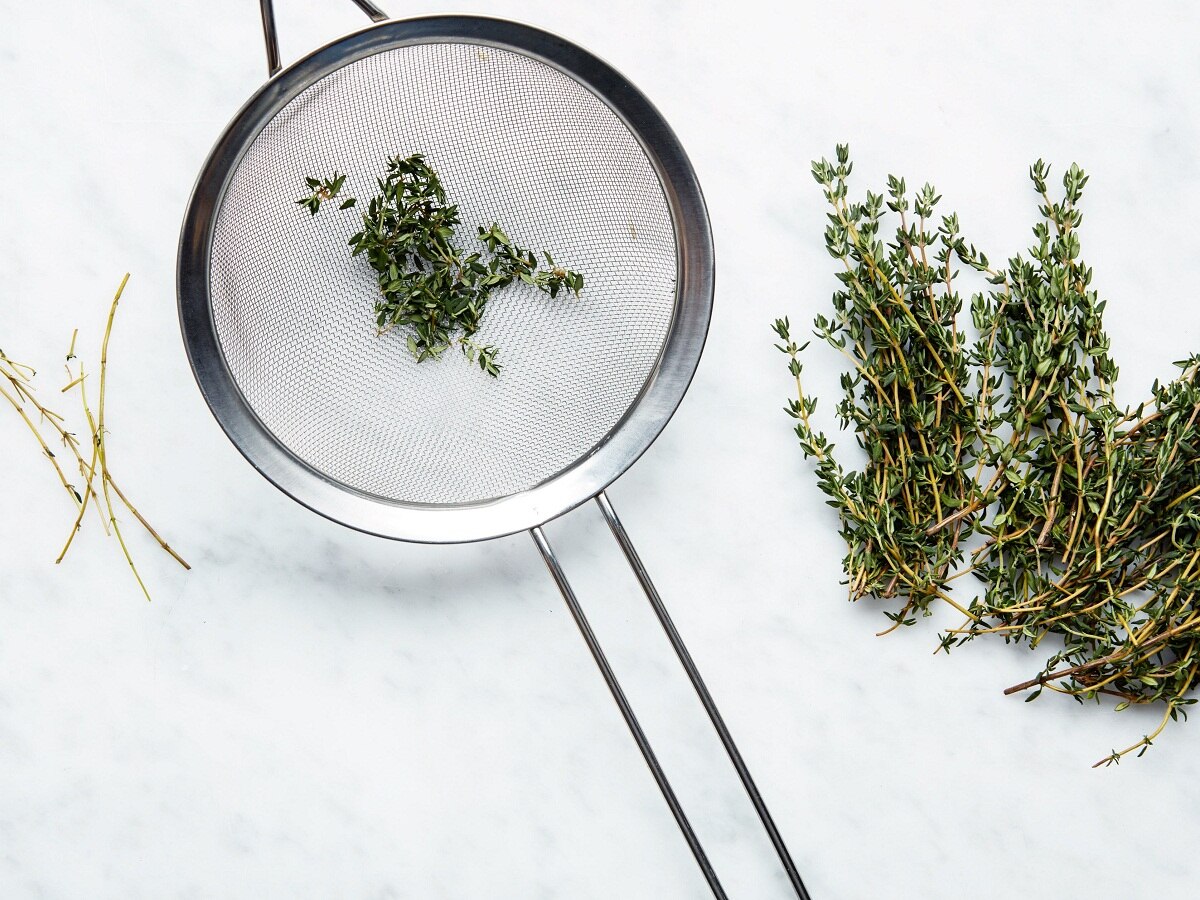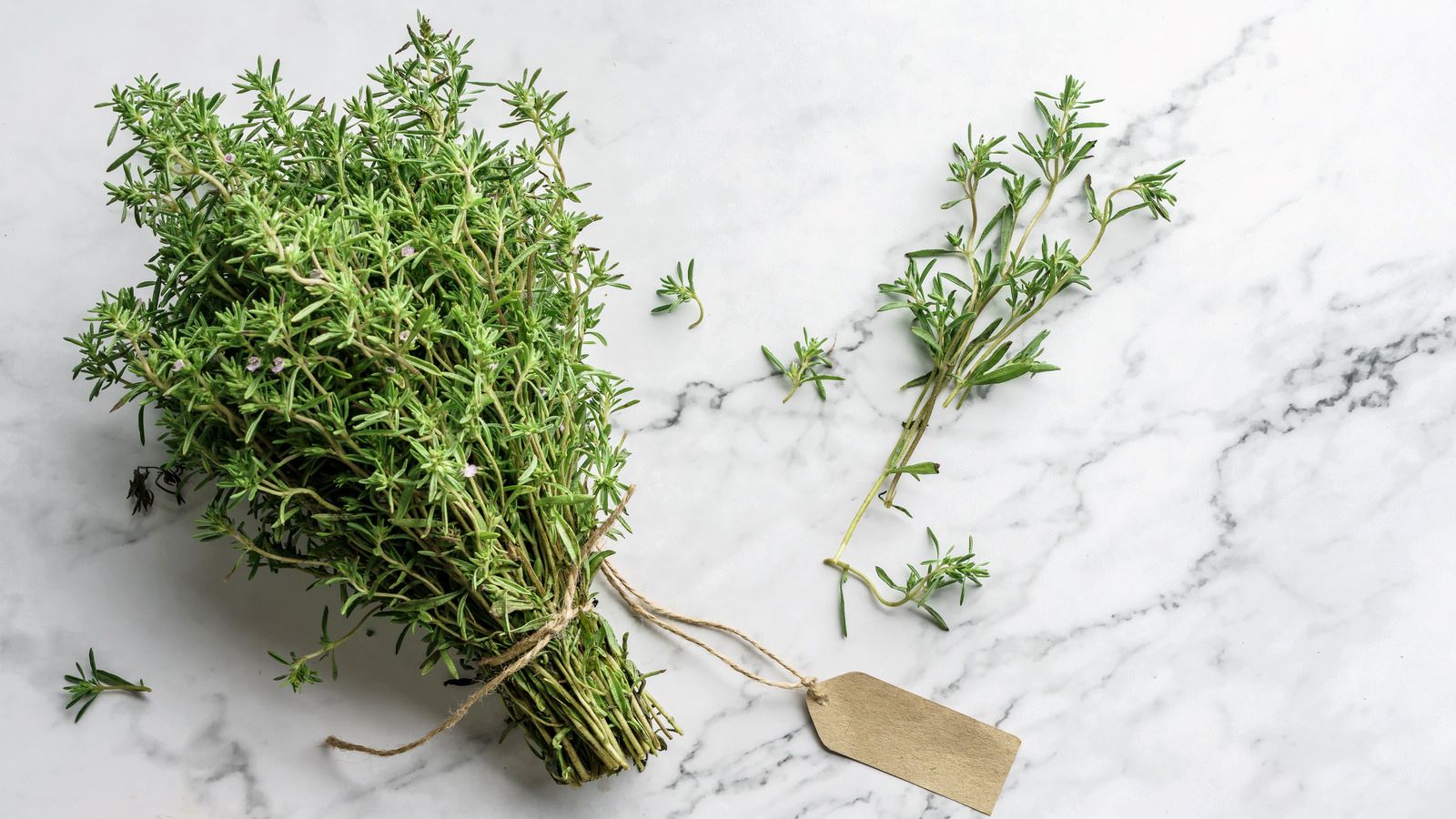Home>Garden Essentials>Garden Plants>How To Clean Fresh Thyme


Garden Plants
How To Clean Fresh Thyme
Modified: April 22, 2024
Learn the best methods to clean fresh thyme plants and enjoy their aromatic flavor in your culinary creations. Step-by-step guide to keeping your plants clean and healthy.
(Many of the links in this article redirect to a specific reviewed product. Your purchase of these products through affiliate links helps to generate commission for Storables.com, at no extra cost. Learn more)
Introduction
Welcome to the world of fresh thyme! If you love cooking with herbs and want to elevate your culinary creations, then fresh thyme is a must-have in your kitchen. With its distinct aroma and versatile flavor, this herb can add a beautiful touch to a wide range of dishes. But before you start incorporating fresh thyme into your recipes, it’s important to know how to properly clean and prepare it.
In this article, we will guide you through a step-by-step process on how to clean fresh thyme. Whether you have just harvested thyme from your garden or bought a bunch from the grocery store, these cleaning techniques will ensure that your thyme is free from dirt and debris, resulting in a delicious and safe addition to your meals.
So, let’s gather our supplies and get ready to dive into the wonderful world of fresh thyme!
Key Takeaways:
- Elevate your culinary creations by properly cleaning and storing fresh thyme. Follow simple steps to ensure your thyme is free from dirt and debris, preserving its aromatic and flavorful qualities.
- Experiment with different thyme varieties and storage methods to enhance your cooking experience. From freezing to infusing in oil, discover the versatility of this herb and elevate your dishes with its unique flavors.
Read more: How To Freeze Fresh Thyme
Supplies Needed
Before we begin cleaning fresh thyme, let’s make sure we have all the necessary supplies on hand. Here’s what you’ll need:
- A bunch of fresh thyme
- A sharp pair of kitchen scissors or herb shears
- A colander or a large bowl
- Cool tap water
- Paper towels or a salad spinner
Once you have these supplies ready, we can proceed to the next steps of cleaning fresh thyme.
Step 1: Harvesting Fresh Thyme
If you have a thyme plant in your garden, you can enjoy the pleasure of harvesting fresh thyme whenever you need it. Here’s how to do it:
- Find a mature thyme plant that is at least six inches tall.
- Choose a time of day when the plant is dry, preferably in the morning after the dew has dried.
- Using a sharp pair of kitchen scissors or herb shears, snip off the desired amount of thyme sprigs just above a set of leaves.
- Be sure not to remove more than one-third of the plant’s foliage to allow for continued growth.
If you don’t have access to a thyme plant, don’t worry! You can still enjoy fresh thyme by purchasing it from a grocery store or farmers market. Just make sure to check for freshness by looking for vibrant green leaves without any signs of wilting or discoloration.
Now that we have harvested our fresh thyme, it’s time to move on to the next step: removing dirt and debris.
Step 2: Removing Dirt and Debris
Before cleaning the fresh thyme, it’s important to remove any dirt and debris that may be clinging to the leaves. Here’s how to do it:
- Fill a large bowl or a colander with cool tap water.
- Place the harvested thyme sprigs into the water.
- Gently swish the thyme around in the water for a few seconds to loosen any dirt or debris.
- Leave the thyme in the water for a minute or two to allow any stubborn dirt to settle at the bottom.
- Slowly lift the thyme out of the water, being careful not to disturb the sediment at the bottom.
By following these steps, you’ll ensure that your fresh thyme is free from any unwanted particles. Now, it’s time to move on to the next step: washing the thyme.
Step 3: Washing the Thyme
After removing the dirt and debris from the fresh thyme, the next step is to give it a thorough wash. Here’s how to do it:
- Fill a clean bowl or sink with cool tap water.
- Submerge the thyme sprigs in the water and gently agitate them with your fingers to ensure all the leaves are cleaned.
- Let the thyme soak in the water for a couple of minutes, allowing any remaining impurities to loosen.
- Once soaked, lift the thyme out of the water, giving it a gentle shake to remove excess moisture.
By washing the thyme, you’ll remove any remaining dirt or residue, leaving you with clean and fresh herbs.
Now that we have washed the thyme, we need to dry it thoroughly before storing or using it in recipes. Let’s move on to the next step: drying the thyme.
To clean fresh thyme, place the sprigs in a bowl of cold water and gently swish them around to remove any dirt or debris. Then, pat them dry with a paper towel before using in your recipe.
Read more: How To Use Fresh Thyme
Step 4: Drying the Thyme
After washing the fresh thyme, it’s essential to dry it properly to prevent any moisture-related issues. Here’s how to do it:
- Option 1: Pat-drying method
- Place a layer of paper towels on a clean, flat surface.
- Gently transfer the washed thyme sprigs onto the paper towels.
- Pat the thyme dry using additional paper towels, removing as much moisture as possible.
- Allow the thyme to air dry for a few hours until completely dry.
- Option 2: Salad spinner method
- Place the washed thyme sprigs into a salad spinner.
- Spin the thyme in the salad spinner for a few seconds to remove excess moisture.
- Remove the thyme from the salad spinner, and if needed, pat it dry with paper towels.
- Allow the thyme to air dry for a few hours until completely dry.
By following these drying methods, you’ll ensure that the thyme is free from excess moisture, which can lead to the growth of mold or an unpleasant texture. Once the thyme is completely dry, it’s time to move on to the final step: storing the fresh thyme.
Step 5: Storing Fresh Thyme
Proper storage is crucial to maintain the freshness and flavor of your freshly cleaned thyme. Here’s how you can store it:
- Option 1: Refrigerator method
- Gently wrap the completely dry thyme sprigs in a damp paper towel.
- Place the wrapped thyme in a resealable plastic bag or an airtight container.
- Store it in the refrigerator’s crisper drawer.
- Thyme stored this way can be kept fresh for up to two weeks.
- Option 2: Freezing method
- Remove the leaves from the thyme sprigs, discarding the woody stems.
- Place the cleaned thyme leaves in an ice cube tray, filling each compartment about three-quarters full.
- Add a small amount of water or olive oil to each compartment to cover the thyme leaves.
- Place the ice cube tray in the freezer until the thyme cubes are completely frozen.
- Transfer the thyme cubes to a labeled freezer-safe container or bag.
- This frozen thyme can be stored for up to six months.
By following these storage methods, you’ll be able to enjoy fresh thyme for an extended period, preserving its flavor and aroma.
Now that you’ve learned how to clean and store fresh thyme, let’s explore some additional tips and tricks to enhance your thyme-related culinary experiences.
Additional Tips and Tricks
Here are some additional tips and tricks to help you make the most out of your fresh thyme:
- Cooking with thyme: Fresh thyme is a versatile herb that can be used in a variety of dishes, including soups, stews, roasted vegetables, and meats. It pairs well with flavors like garlic, lemon, and olive oil.
- Drying thyme: If you want to dry thyme for long-term storage, you can hang the cleaned sprigs in a well-ventilated area until they are completely dried. Once dried, remove the leaves from the stems and store them in an airtight container.
- Preserving thyme in oil: Another way to store fresh thyme is by infusing it in oil. Place the thyme sprigs in a jar, cover them with olive oil, and store the jar in the refrigerator. This infused oil can be used in dressings, marinades, or drizzled over dishes.
- Labeling and dating: Whether you’re storing thyme in the refrigerator or freezer, it’s essential to label and date the containers or bags. This will help you keep track of the thyme’s freshness and ensure you use it within the recommended storage time.
- Using frozen thyme: When cooking with frozen thyme cubes, you can add them directly to dishes without thawing. The heat will quickly melt the cubes, releasing the flavors into your recipe.
- Experiment with different varieties: Thyme comes in various varieties, such as lemon thyme, French thyme, and creeping thyme. Each variety has its own unique flavor profile, so feel free to explore and experiment with different types to discover your favorites.
By incorporating these tips and tricks, you’ll be able to make the most out of your fresh thyme, elevating your culinary creations and enhancing your dishes with its aromatic and flavorful presence.
Now that you’re equipped with the knowledge of how to clean, store, and use fresh thyme, it’s time to get creative in the kitchen and enjoy the wonderful world of this versatile herb!
Happy thyme cooking!
Conclusion
Cleaning fresh thyme is an essential step in preparing this versatile herb for culinary use. By following the simple steps outlined in this guide, you can ensure that your thyme is free from dirt and debris, allowing you to fully enjoy its aromatic and flavorful qualities.
From harvesting the thyme to removing dirt and debris, washing, drying, and storing it, each step plays a crucial role in maintaining the freshness and quality of this herb. By taking the time to clean and properly store your thyme, you can extend its shelf life and have it readily available whenever you need to add a burst of flavor to your dishes.
Remember to experiment with different recipes and varieties of thyme to discover your preferred flavors and combinations. Whether you choose to dry thyme for later use, infuse it in oil, or freeze it for long-term storage, the options are endless when it comes to utilizing this versatile herb in your cooking.
So, the next time you bring a bunch of fresh thyme into your kitchen, use the techniques discussed in this article to clean it properly and enhance your culinary creations. With a little care and attention, you can make the most of your fresh thyme and elevate your dishes to a whole new level of deliciousness.
Now, it’s time to roll up your sleeves, get cooking, and savor the incredible flavors that fresh thyme can bring to your meals. Enjoy!
Frequently Asked Questions about How To Clean Fresh Thyme
Was this page helpful?
At Storables.com, we guarantee accurate and reliable information. Our content, validated by Expert Board Contributors, is crafted following stringent Editorial Policies. We're committed to providing you with well-researched, expert-backed insights for all your informational needs.















0 thoughts on “How To Clean Fresh Thyme”